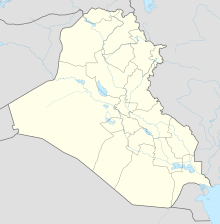품베디타
Pumbeditaפומבדיתא | |
| 위치 | |
|---|---|
| 좌표 | 33°21′04″N 43°47′10″E / 33.351111°N 43.786111°E |
Pumbedita (sometimes Pumbeditha, Pumpedita, or Pumbedisa; Aramaic: פוּמְבְּדִיתָא Pūmbəḏīṯāʾ, "The Mouth of the River,"[1]) was an ancient city located near the modern-day city of Fallujah, Iraq. 품베디타 아카데미를 주최한 것으로 알려져 있다.
역사
움베디타 시는 예루살렘 제2신전 시절부터 유대인 인구를 보유하고 있었다고 한다.[2]
이 도시는 많은 유대인 인구를 가지고 있었고 푸메디타 아카데미로 유명했다. 푸메디타 아카데미는 수라시와 함께 바빌로니아 탈무드를 낳았다. 그곳의 아카데미는 3세기 후반에 유다 벤 에스겔에 의해 설립되었다. 그 아카데미는 네하르데아의 아카데미가 파괴된 후 설립되었다. 수도인 네하르데아는 페르시아-팔미리아 전쟁 중에 파괴되었다.
투델라의 벤자민에 대한 12세기 여행 설명은 다음과 같은 설명을 제공한다.
- [모술에서 온 이틀은 주바인데] 주바(Juba)는 네하르데아의 움베디타(Pumbeditha)로 약 2천 명의 유대인을 포함하고 있으며, 그들 중 일부는 저명한 학자다. 랍비 R. 첸, R. 모쉐와 R. 엘리아킴이 그들 중 한 명이다. 여기서 여행자는 R의 분막을 볼 수 있다. Jehuda와 R. 생전에 세운 두 개의 회당과 R의 회당과 반대편에 있다. 포로들의 왕자 보스테나이 R. 네이쓴과 R. 나흐만 B. 아빠[3]
이븐 세라피온(ca.900)에서 건설된 압바시드 시대의 메소포타미아 지리에 있는 가이 르 스트레인지(Guy Le Streger)는 움베디타(Pumbedita)의 가능한 위치를 다음과 같이 언급하고 있다.
- The Nahr-al-Badāt (or Budāt) was a long drainage channel taken from the left bank of the Kūfah arm of the Euphrates, at a day’s journey to the north of Kūfah city, probably near the town of Kanṭarah-al-Kūfah, otherwise called Al-Kanāṭīr, ‘the Bridges,’ which doubtless carried the high road across the Badāt. This city of ‘the Bridges’ lay 27 miles south of the great Sūrā bridge of boats, and 28 miles north of Kūfah; and it probably lay adjacent to, or possibly was identical with, the Hebrew Pombedita (Arabic Fam-al-Badāt, ‘mouth of the Badāt canal’)”, mentioned by Benjamin of Tudela as a great centre of Jewish learning in Babylonia.[4]
참고 항목
참조
- ^ 바빌로니아 탈무드(Kiddusin 72a-b)에서 따와 카이로 게니자에서 발견된 구절에 대한 지오닉 논평은 다음과 같이 읽는다. "...그러므로 우리는 바히타 레바(즉, 강이 범람하고 있다)라고 말한다. 모든 사람이 들어와서 물고기를 건져낸다. 많은 수가 안으로 들어오기 시작하면, 그들은 갇혀서 거기에서 꺼낸다. 자, 이 일은 잔치가 열리는 중간 날에 일어난다. 바히타에 대해서는 강을 [만족]하고, 입구를 쿰바히타(품베디타)라고 한다. 그러나 지금은 아라비아어로는 알바다(알바디야)라고 한다."
- ^ 바빌로니아 탈무드(Bilbonian Talmud)에 따르면 Igggret Rav Sherira Gaon, Rosh Hasanah 23b.
- ^ The itinerary of Rabbi Benjamin of Tudela; transl., edit. A. Asher, 1800-1853; Zunz, Leopold, 1794-1886; Lebrecht, Fuerchtegott Schemaja, 1800-1876. Publ. New York: "Hakesheth" pub. Co.
- ^ Le Strange, Guy (1905). The Lands of the Eastern Caliphate: Mesopotamia, Persia, and Central Asia, from the Moslem Conquest to the Time of Timur. New York: Barnes & Noble, Inc. OCLC 1044046.



